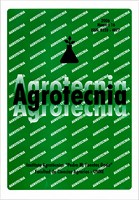View Item
- xmlui.general.dspace_homeCentros Regionales y EEAsCentro Regional Santa FeEEA RafaelaArtículos científicosxmlui.ArtifactBrowser.ItemViewer.trail
- DSpace Home
- Centros Regionales y EEAs
- Centro Regional Santa Fe
- EEA Rafaela
- Artículos científicos
- View Item
Variabilidad genotípica y ambiental del peso, tamaño y aceite del grano de girasol (Helianthus annuus L.) en el Noreste argentino
Abstract
La relación tegumento/embrión es uno de los principales factores que afectan el porcentaje de aceite en girasol. Mayores proporciones de embrión incrementa la cantidad de aceite del grano. En la actualidad, no es claro el efecto ambiental y la variabilidad genotípica en híbridos modernos de girasol de la relación tegumento/embrión y el porcentaje de aceite del grano. Los objetivos de este trabajo fueron i) determinar la variabilidad genotípica y ambiental
[ver mas...]
La relación tegumento/embrión es uno de los principales factores que afectan el porcentaje de aceite en girasol. Mayores proporciones de embrión incrementa la cantidad de aceite del grano. En la actualidad, no es claro el efecto ambiental y la variabilidad genotípica en híbridos modernos de girasol de la relación tegumento/embrión y el porcentaje de aceite del grano. Los objetivos de este trabajo fueron i) determinar la variabilidad genotípica y ambiental para porcentaje de aceite y proporción de tegumento y embrión en el Noreste Argentino y ii) analizar la influencia de variables ambientales sobre la relación de tegumento/embrión y el porcentaje de aceite del grano de girasol. Se realizaron 4 experimentos durante la campaña 2014/2015 en las localidades de Reconquista (en dos fechas de siembra), Ceres y Villa Ocampo. Los tratamientos consistieron en una combinación de cuatro ambientes y quince híbridos comerciales de girasol. Las determinaciones realizadas fueron tipo de grano, tamaño (largo y ancho), peso de grano, peso y espesor del tegumento, peso del embrión, contenido de aceite de embrión y grano. Se realizaron análisis de componentes principales para explicar las relaciones de cada componente con las variables medidas. El porcentaje de aceite varió entre 55,2 y 43,3, mientras que el porcentaje de aceite de embrión varió entre 53,5 y 66,4%. En el porcentaje de aceite en el grano y relación tegumento/embrión se observaron diferencias significativas entre híbridos y ambientes. El rango obtenido en peso de grano fue de 29 a 91 mg. Uno de los factores ambientales más importantes que se relacionó con las variables fue la temperatura máxima y media durante el llenado de granos. Estos resultados contribuyen a la toma de decisiones sobre estabilidad y adaptación genotípica como así también herramienta para el mejoramiento genético para incrementar el porcentaje de aceite de futuros híbridos.
[Cerrar]
The coat/embryo ratio is one of the main factors affecting the percentage of sunflower oil. Higher
proportions of seed embryo increase the amount of oil in grain. Currently, environmental effect and
genetic variability in modern hybrid sunflower coat/embryo ratio and the percentage of grain oil is
unclear. The objectives of this study were i) determine the genotypic and environmental variability
for oil percentage and ratio of seed coat and embryo in
[ver mas...]
The coat/embryo ratio is one of the main factors affecting the percentage of sunflower oil. Higher
proportions of seed embryo increase the amount of oil in grain. Currently, environmental effect and
genetic variability in modern hybrid sunflower coat/embryo ratio and the percentage of grain oil is
unclear. The objectives of this study were i) determine the genotypic and environmental variability
for oil percentage and ratio of seed coat and embryo in the northeastern regions of Argentina and ii)
analyze the influence of environmental variables on the coat/embryo ratio and oil content sunflower
grain. Four experiments during the 2014/2015 growing season were made in Reconquista (in two
planting dates), Ceres and Villa Ocampo. The treatments consist in a combination of four environmental conditions by fifteen sunflower commercial hybrids. The determinations were grain type, size (length and width), whole grain weight, weight and thickness of the seed coat, embryo weight and oil content of embryo. Principal component analyses were performed to explain the relationships of each component with the measured variables. The percentage of oil ranged from 55,2 and 43,3%, while
the percentage of seed embryo varied from 53,5 to 66,4%. The grain oil percentage and coat/embryo
ratio showed significant differences among hybrids and ambient. The range obtained for grain weight
ranged from 29 to 91 mg. One of the most important environmental factors related to the variables was
maximum and mean temperature during grain filling. These results contribute to decide on adaptation and genotypic stability as well as a tool for breeding programs to increase the f oil percentage of
future hybrids.
[Cerrar]

Author
Rocca, Paola;
Martino, Laureano;
Rausch, Analia Fabiana;
Zuil, Sebastian;
Fuente
Agrotecnia / Universidad Nacional del Nordeste 26 : 5-16. (2017)
Date
2017
Editorial
Facultad de Ciencias Agrarias, Universidad Nacional del Nordeste
ISSN
0328-4077
2545-8906
2545-8906
Formato
pdf
Tipo de documento
artículo
Palabras Claves
Derechos de acceso
Abierto
 Excepto donde se diga explicitamente, este item se publica bajo la siguiente descripción: Creative Commons Attribution-NonCommercial-ShareAlike 2.5 Unported (CC BY-NC-SA 2.5)
Excepto donde se diga explicitamente, este item se publica bajo la siguiente descripción: Creative Commons Attribution-NonCommercial-ShareAlike 2.5 Unported (CC BY-NC-SA 2.5)


